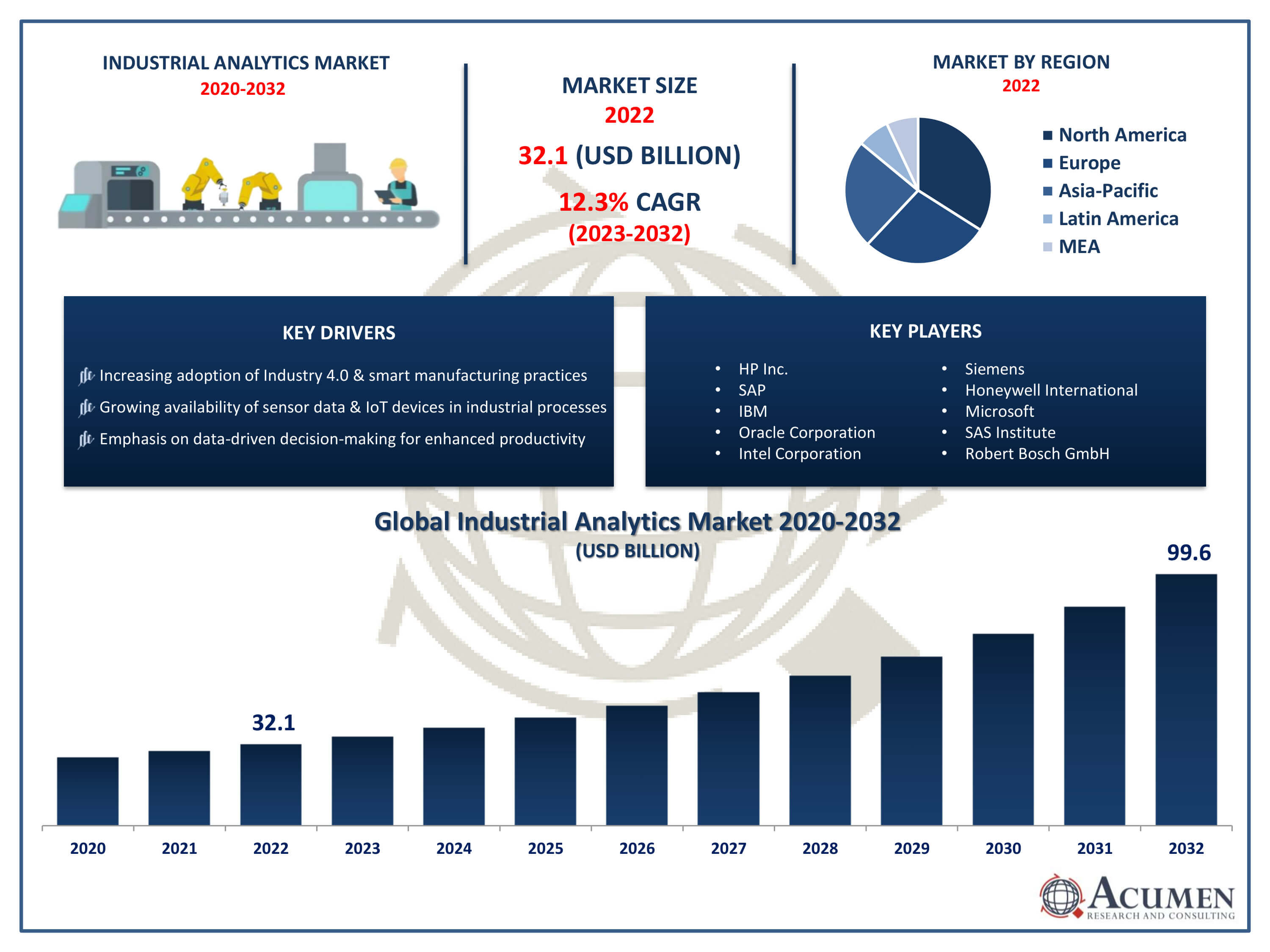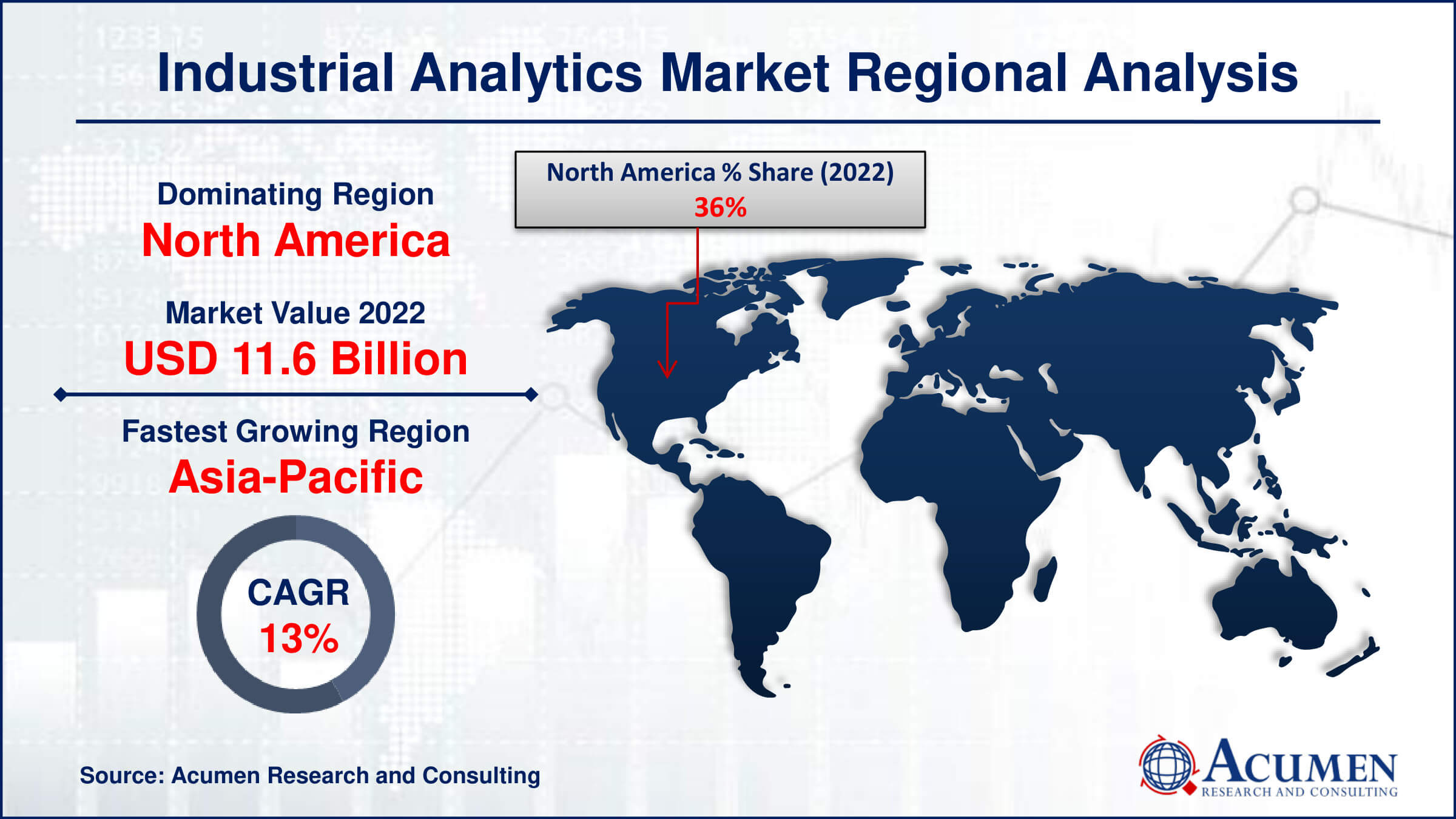February 2024
Industrial Analytics Market Size accounted for USD 32.1 Billion in 2022 and is projected to achieve a market size of USD 99.6 Billion by 2032 growing at a CAGR of 12.3% from 2023 to 2032.
The Industrial Analytics Market Size accounted for USD 32.1 Billion in 2022 and is projected to achieve a market size of USD 99.6 Billion by 2032 growing at a CAGR of 12.3% from 2023 to 2032.
Industrial Analytics Market Highlights

Industrial analytics refers to the use of advanced data analysis tools and techniques to extract valuable insights from the vast amount of data generated within industrial processes. This includes manufacturing, supply chain management, maintenance, and other operational aspects of industries. The goal is to enhance efficiency, optimize processes, reduce downtime, and make data-driven decisions that contribute to overall operational excellence. Industrial analytics leverages technologies such as machine learning, artificial intelligence, and big data analytics to transform raw data into actionable insights, enabling organizations to improve productivity and competitiveness.
The market for industrial analytics has experienced significant growth in recent years and is expected to continue expanding. As industries increasingly recognize the importance of data-driven decision-making, the demand for advanced analytics solutions tailored to industrial settings has surged. Factors contributing to this growth include the rise of Industry 4.0, which emphasizes the integration of digital technologies into industrial processes, as well as the growing availability of sensor data and IoT (Internet of Things) devices in industrial environments. The adoption of industrial analytics is seen across various sectors, including manufacturing, energy, transportation, and healthcare, as organizations seek to capitalize on the benefits of predictive maintenance, quality optimization, and overall operational efficiency improvements.
Global Industrial Analytics Market Trends
Market Drivers
Market Restraints
Market Opportunities
Industrial Analytics Market Report Coverage
| Market | Industrial Analytics Market |
| Industrial Analytics Market Size 2022 | USD 32.1 Billion |
| Industrial Analytics Market Forecast 2032 | USD 99.6 Billion |
| Industrial Analytics Market CAGR During 2023 - 2032 | 12.3% |
| Industrial Analytics Market Analysis Period | 2020 - 2032 |
| Industrial Analytics Market Base Year |
2022 |
| Industrial Analytics Market Forecast Data | 2023 - 2032 |
| Segments Covered | By Component, By Analytics Type, By Deployment Model, By End Use, And By Geography |
| Regional Scope | North America, Europe, Asia Pacific, Latin America, and Middle East & Africa |
| Key Companies Profiled | HP Inc., SAP, IBM, Oracle Corporation, Intel Corporation, Siemens, Honeywell International, Microsoft, SAS Institute, Robert Bosch GmbH, TIBCO Software, and Rockwell Automation. |
| Report Coverage |
Market Trends, Drivers, Restraints, Competitive Analysis, Player Profiling, Covid-19 Analysis, Regulation Analysis |
Industrial analytics is a specialized field that involves the use of advanced data analysis tools and technologies to extract actionable insights from the vast amount of data generated within industrial processes. It leverages techniques such as machine learning, artificial intelligence, and big data analytics to transform raw data from various sources, including sensors, machines, and production systems, into meaningful information. The primary goal of industrial analytics is to enhance operational efficiency, optimize processes, and facilitate data-driven decision-making in industries such as manufacturing, energy, transportation, and healthcare. The applications of industrial analytics are diverse and impactful across various industrial sectors. One key area is predictive maintenance, where analytics is used to predict equipment failures before they occur, minimizing downtime and reducing maintenance costs. Quality optimization is another critical application, where analytics helps identify patterns and factors affecting product quality, leading to improved manufacturing processes.
The industrial analytics market has witnessed robust growth in recent years and continues to expand as industries recognize the transformative potential of data analytics in optimizing their operations. With the advent of Industry 4.0 and the increasing adoption of IoT devices and sensors, industrial processes generate vast amounts of data. Organizations are leveraging industrial analytics to extract meaningful insights from this data, enabling them to enhance efficiency, reduce costs, and make more informed decisions. The demand for predictive maintenance, real-time monitoring, and overall operational optimization has been a key driver for the adoption of industrial analytics across various sectors such as manufacturing, energy, and transportation. As companies increasingly prioritize digital transformation and the integration of smart technologies into their workflows, the industrial analytics market is expected to experience sustained growth.
Industrial Analytics Market Segmentation
The global Industrial Analytics Market segmentation is based on component, analytics type, deployment model, end use, and geography.
Industrial Analytics Market By Component
According to the industrial analytics industry analysis, the hardware segment accounted for the largest market share in 2022. This growth is driven by the increasing demand for advanced computing capabilities, edge processing, and connectivity solutions within industrial environments. As industries embrace the digital transformation brought forth by Industry 4.0, there is a growing need for robust hardware infrastructure to support the processing and analysis of large volumes of data generated by sensors and IoT devices. Edge computing, in particular, has gained prominence, allowing organizations to perform analytics closer to the data source, reducing latency and enhancing real-time decision-making in industrial settings. One key driver of the hardware segment's growth is the proliferation of IoT devices and industrial sensors that continuously generate data on the factory floor. The hardware components, including servers, gateways, and edge devices, play a crucial role in processing this data efficiently.
Industrial Analytics Market By Analytics Type
In terms of analytics types, the descriptive segment is expected to witness significant growth in the coming years. Descriptive analytics involves the analysis of historical data to gain insights into what has happened within an industrial system. This segment plays a critical role in helping organizations comprehend past performance, identify inefficiencies, and optimize processes. As industries strive for operational excellence, the ability to retrospectively analyze data and draw meaningful conclusions has become a fundamental aspect of their overall analytics strategy. One of the key drivers behind the growth of descriptive analytics in the industrial sector is the need for enhanced visibility into historical performance metrics. This form of analytics enables businesses to track key performance indicators (KPIs), monitor production trends, and identify areas for improvement.
Industrial Analytics Market By Deployment Model
According to the industrial analytics market forecast, the cloud segment is expected to witness significant growth in the coming years. Cloud computing offers scalability, flexibility, and cost-effectiveness, making it an attractive option for organizations seeking to harness the power of analytics without the need for extensive on-premises infrastructure. Industrial players are increasingly migrating their analytics workloads to the cloud to leverage the benefits of real-time data access, collaboration, and the ability to deploy advanced analytics models at scale. One key driver of the growth in the cloud segment is the demand for centralized data storage and accessibility. Cloud platforms provide a secure and centralized repository for industrial data, enabling organizations to break down data silos and facilitate seamless collaboration across departments and locations.
Industrial Analytics Market By End Use
Based on the end use, the manufacturing segment is expected to continue its growth trajectory in the coming years. This growth is propelled by the increasing integration of data analytics solutions to enhance efficiency, productivity, and quality in manufacturing processes. Industry 4.0 has played a pivotal role in driving this growth, as manufacturers embrace digital technologies, IoT devices, and data-driven insights to optimize their operations. Industrial analytics in manufacturing involves the analysis of data generated by sensors and machinery on the shop floor, enabling real-time monitoring, predictive maintenance, and overall process optimization. One of the key drivers behind the growth of industrial analytics in manufacturing is the pursuit of operational excellence. Manufacturers are leveraging analytics to gain deeper visibility into their production processes, identify bottlenecks, and streamline workflows.
Industrial Analytics Market Regional Outlook
North America
Europe
Asia-Pacific
Latin America
The Middle East & Africa

Industrial Analytics Market Regional Analysis
North America has emerged as a dominating region in the industrial analytics market due to several factors that collectively contribute to its leadership in this space. One key factor is the robust technological infrastructure present in the region, with advanced connectivity, widespread adoption of IoT devices, and a well-established network of data centers. The United States, in particular, has been at the forefront of Industry 4.0 initiatives, driving the integration of digital technologies and fostering a favorable environment for industrial analytics adoption across various sectors. The strong presence of key industrial players and technology giants in North America has significantly contributed to the region's dominance in the industrial analytics market. These companies are at the forefront of developing and implementing cutting-edge analytics solutions, influencing the overall technological landscape and setting industry standards. Moreover, the region's proactive approach to innovation and research and development activities further accelerates the growth of industrial analytics. The regulatory environment and government initiatives supporting digital transformation and technological advancements also play a crucial role in fostering a conducive ecosystem for the widespread adoption of industrial analytics solutions in North America.
Industrial Analytics Market Player
Some of the top industrial analytics market companies offered in the professional report include HP Inc., SAP, IBM, Oracle Corporation, Intel Corporation, Siemens, Honeywell International, Microsoft, SAS Institute, Robert Bosch GmbH, TIBCO Software, and Rockwell Automation.
Looking for discounts, bulk pricing, or custom solutions? Contact us today at sales@acumenresearchandconsulting.com
February 2024
May 2025
August 2023
December 2020